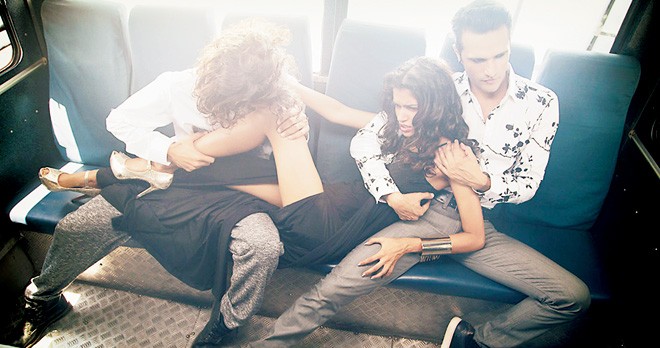
The recent trend of photo shoots that glorify violence against women is not only controversial but also seriously damaging to society's perceptions about the role of the female

A woman cowers in the corner, her face contorted with fear, as an axe-wielding butcher descends in her direction. Another stares stonily ahead, her immaculately made up face expressionless except for the grotesque Glasgow smile sliced across her mouth. Several others, in varying states of undress, are brutishly pinned down by gangs of men in broad daylight – one in an alley, another on a high-rise rooftop and one more in the back of a bus.
These scenes aren’t stills from slasher films. One wishes such images were confined to the perverse viewing pleasure of a niche audience, but this unfortunately is not the case. These scenes – gory, violent, the stuff of bad dreams for some and nightmarish realities for others – are the products of high fashion photography, strewn across the pages of magazines that collectively constitute the bible of the global fashion industry. Women and young girls are watching.
Woman #1 wears Marc Jacobs in a Vogue Italia shoot that claimed to raise awareness about domestic violence, but ultimately painted the women as helpless victims. Woman #2 is part of a beauty spread titled Victims of Beauty in Bulgarian fashion publication 12 that had no response to the subsequent uproar except that the photographs are open to interpretation, but they’re glad they got people’s attention. Woman #3 was helping sell Calvin Klein jeans; Woman #4 marketed Dolce & Gabbana. All of these shoots, shot between the years 2007 and 2014, were denounced for their objectification of women, but the trope of the battered, bloodied woman shows no signs of fading away.
Woman #5 (pictured here) is the most recent addition to the grotesque set of so-called awareness campaigns. Clad in couture, the model is shown being attacked by a trio of would-be rapists in a series of images titled The Wrong Turn, photographed and shared on online portfolio-sharing forum Behance by a Raj Shetye. If he was once unknown to the casual reader of fashion magazines, this is no longer the case.
Like its controversial predecessors, The Wrong Turn has been the subject of backlash from the world over for its stark similarity to the Nirbhaya gang rape in Delhi that shocked India and the world. Although he maintains his concept and shoot predated the attack, Shetye released the photographs in early August, when the shocking rape incident, which took place a year and a half ago in December 2012, is still fresh in collective memory. Every major online publication had something to say about the shoot. Perhaps it is mission accomplished for Shetye. He hasn’t been the first to grab attention through such tasteless means, though he insists that his purpose was to highlight the fact that women from all classes are vulnerable to such attacks. By the looks of it, he won’t be the last.
Violence against women is a theme in fashion photography that dates back to the 1970s when Guy Bourdin and Helmut Newton, the two fathers of highly eroticised, borderline pornographic fashion photography, started creating violent, sexually aggressive spreads, primarily for Vogue and Harper’s Bazaar. The former suffered the trials of maternal abandonment in his formative years, while the other escaped the persecution of Nazi troops when he was 18. Not to take anything from their genius, but two traumatized individuals paved the way for the use of bloodied, battered women as props through their lens, and they have had many imitators since.
This is not entirely surprising, since the fashion industry is known to bank on shock value. Shock value grabs eyeballs and it sells. This is fair enough, because mass media in general relies on antics of some kind to pique and sustain interest. (Take news channel sensationalism, for example.) But it’s important to scrutinise these supposedly fashion-forward images of violence and victimised women because they strengthen some truly dangerous notions about women.
Shetye insists that the message of the universality of female vulnerability is worthy of being put across to hundreds of thousands of online viewers. If, for the sake of argument, one holds the shoot as a well-intentioned project, one still cannot ignore that it contradicts itself in the stylistic decisions made by Shetye. For one, the beautiful model is shown as ‘worthy of abuse’, as if by adorning herself in haute couture, she ‘asked for it’. This only reinforces the highly damaging mindset held by society about rape victims. And second, her attackers are lean and muscular, tall and good-looking – aspirational body ideals that are perpetuated through mass media. Male viewers, who desire to look like the attackers, are also receiving the message that violent, sexual aggression is another means of acquiring masculinity. The bottom line is that the main consumers of fashion magazines – that is, women and young girls – are shown yet again that their role is merely that of the helpless victim. Shetye’s shoot contributes to rape culture instead of speaking up against it.
Perhaps it would be more prudent then for the fashion industry at large to abstain from using images of victimised women at all, for magazines to refuse to use images that objectify women in this manner, for photographers to suggest amendments to briefs that require them to create such portrayals, instead of trying to frame a comment on instances of female abuse with a re-enactment of a harrowing crime.